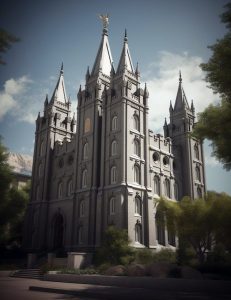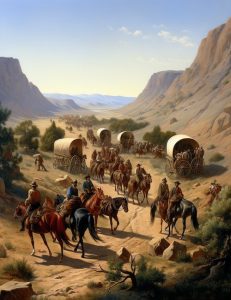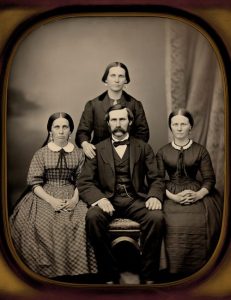Is the Church of Jesus Christ of Latter-Day Saints (The Mormons) a cult?
AN INTRODUCTION
 The Church of Jesus Christ of Latter-Day Saints (LDS), often called Mormons, stands as one of the most unique and rapidly growing religious movements in the modern world. Its unique teachings, practices, and history have fascinated believers and sceptics alike. This blog aims to delve into its origins, beliefs, and controversies over the past two centuries and answer the question, ‘Is the Church of Jesus Christ of Latter-Day Saints (Mormons) a cult?’
The Church of Jesus Christ of Latter-Day Saints (LDS), often called Mormons, stands as one of the most unique and rapidly growing religious movements in the modern world. Its unique teachings, practices, and history have fascinated believers and sceptics alike. This blog aims to delve into its origins, beliefs, and controversies over the past two centuries and answer the question, ‘Is the Church of Jesus Christ of Latter-Day Saints (Mormons) a cult?’
Is the Church of Jesus Christ of Latter-Day Saints (The Mormons) a cult?
A BRIEF HISTORY
Origins in the Burned-Over District
The early 19th century saw a fervour of religious revivalism in the northeastern United States, particularly in the area known as the Burned-Over District in upstate New York. A young Joseph Smith, amidst the multitude of religious sects and fervent evangelism, claimed to have received his first vision in 1820. At 14, Smith said he was visited by God the Father and Jesus Christ, who told him all existing churches had strayed from the true gospel.
The Book of Mormon: Another Testament of Jesus Christ
 In 1823, Smith alleged that an angel named Moroni appeared to him, revealing the location of a buried set of golden plates near his home. After obtaining and translating these plates through what he described as divine inspiration, Smith published the Book of Mormon in 1830. This book considered a companion to the Bible, recounts the story of ancient Israelites who journeyed to the Americas and their subsequent civilizations and interactions with Jesus Christ after His resurrection.
In 1823, Smith alleged that an angel named Moroni appeared to him, revealing the location of a buried set of golden plates near his home. After obtaining and translating these plates through what he described as divine inspiration, Smith published the Book of Mormon in 1830. This book considered a companion to the Bible, recounts the story of ancient Israelites who journeyed to the Americas and their subsequent civilizations and interactions with Jesus Christ after His resurrection.
Establishment and Early Growth
With the Book of Mormon as its central scripture, The Church of Jesus Christ of Latter-Day Saints was formally organized on April 6, 1830, in Fayette, New York. The unique teachings of Smith, combined with practices like polygamy, led to tensions with non-Mormon neighbours.
Nauvoo: A City and a Temple
By 1839, Smith and his followers had established a new city called Nauvoo on the banks of the Mississippi River in Illinois. Nauvoo grew rapidly and became one of the largest cities in the state. It was here that significant doctrines were revealed, and the construction of the Nauvoo Temple began. However, internal divisions and external pressures once again led to conflict.
Martyrdom and Succession Crisis
Tensions in Nauvoo culminated in the arrest of Joseph Smith and his brother, Hyrum, in 1844. Both were assassinated by a mob while awaiting trial in Carthage, Illinois. Their deaths threw the church into a succession crisis. Brigham Young, a senior apostle, emerged as the key leader and would lead the church’s next significant phase.
The Great Migration to Utah
Facing continued persecution, Young boldly relocated the Latter-Day Saints to the West, where they hoped to practice their faith without interference. The perilous journey across the American continent, marked by hardship, sacrifice, and faith, culminated in the establishment of Salt Lake City in the Utah Territory in 1847.
The Struggle with the U.S. Government
The late 19th century brought challenges as the U.S. government took issue with LDS practices, especially polygamy. A series of legal actions targeted the church, leading to the confiscation of assets and even the imprisonment of church leaders. This pressure eventually led to the church’s official abandonment of polygamy in 1890 through the Manifesto issued by then-President Wilford Woodruff.
Modern Growth and Global Expansion
 The 20th and 21st centuries have seen the LDS Church grow exponentially, with a significant membership outside the U.S. Its missionary program, centralized leadership, and emphasis on family and moral values have attracted millions worldwide. Today, the church boasts a diverse, global membership, making it one of the most influential religious movements of the modern era.
The 20th and 21st centuries have seen the LDS Church grow exponentially, with a significant membership outside the U.S. Its missionary program, centralized leadership, and emphasis on family and moral values have attracted millions worldwide. Today, the church boasts a diverse, global membership, making it one of the most influential religious movements of the modern era.
Is the Church of Jesus Christ of Latter-Day Saints (The Mormons) a cult?
THE CONTROVERSIES
1. The Book of Abraham
In 1835, a travelling exhibit arrived in Kirtland, Ohio, containing Egyptian mummies and papyri. Joseph Smith expressed interest in these artifacts and purchased them with financial contributions from other members. Smith claimed the papyri contained writings of Abraham’s life, complex cosmology and a vision of pre-Earth life. Much like the Book of Mormon translation, Joseph Smith didn’t provide detailed specifics on how he translated the papyri. However, he described it as a revelation, suggesting he was given the ability to understand the spiritual or divine meaning of the symbols rather than a direct linguistic translation.
The surviving papyri were thought lost but were rediscovered in the 1960s. When analyzed by Egyptologists, they identified them as common funerary texts (specifically, the “Book of Breathings”) unrelated to Abraham.
2. Curse of the Negros
The term “Curse of the Negros” or “Curse of Cain” refers to past beliefs and policies in the LDS Church that linked black skin colour to a biblical curse and used it as a theological justification for racial discrimination, particularly the denial of temple ordinances and the priesthood to black members. This doctrine and subsequent practices are among LDS Church history’s most controversial and debated aspects.
Biblical Origins. The concept of the “Curse of Cain” has roots in the Bible, where Cain is cursed by God for murdering his brother Abel. Over time, various Christian denominations interpreted the “mark of Cain” mentioned in Genesis as black skin, though the Bible doesn’t describe the mark in this way.
LDS Interpretation. The Curse of Cain was expanded upon, intertwining with other scriptural narratives.
- Book of Mormon. The Book of Mormon tells of the Lamanites, who were cursed with a “skin of blackness” due to their wickedness. Though not directly linked to the Curse of Cain, it reinforced some early LDS views on skin colour and righteousness.
- Pearl of Great Price. The curse stemming from Cain’s actions is mentioned in the LDS scriptural book, The Pearl of Great Price. Some early LDS interpretations claimed that those of African descent were lineage holders of Cain, carrying his curse, which was believed to include a ban on holding the priesthood.
Priesthood and Temple Ban. Starting from Brigham Young’s leadership in the mid-19th century, black male members of the LDS Church were barred from receiving the priesthood, a significant aspect of male participation in the church. The barring included participating in temple endowments or sealings—essential ordinances in LDS theology. This policy continued until 1978.
3. Mark Hofmann
Growing up as a member of the LDS Church in Utah, Hofmann became disillusioned with his faith during his teenage years. However, he was familiar with church history, which later served him in his forgeries. His first significant forgery was a supposed 1830 reprint of the King James Bible. Within this “reprint,” Hofmann inserted a folded page purported to be the transcript Joseph Smith used to confirm the authenticity of the golden plates from which the Book of Mormon was translated.
Over the years, Hofmann “discovered” and sold many significant documents related to LDS history, including the “Salamander Letter,” which suggested that an angel with a salamander-like appearance had appeared to Smith, contradicting the church’s official account of the First Vision.
4. The Mountain Meadows Massacre
 The Mountain Meadows Massacre is one of the most tragic and controversial episodes in the LDS Church and the American West. A wagon train of emigrants, primarily from Arkansas, was passing through Utah on its way to California. On September 7, the wagon train was besieged by a group of Mormon militiamen and Paiute warriors. After a five-day siege, local Mormon leader John D. Lee approached the wagon train under a white flag of truce. He offered safe passage to the emigrants if they left their weapons and livestock behind. However, once they were led away from their encampment, the Mormon militia and some Paiute members turned on the emigrants, killing around 120 men, women, and children. Only 17 children, all under the age of seven, were spared.
The Mountain Meadows Massacre is one of the most tragic and controversial episodes in the LDS Church and the American West. A wagon train of emigrants, primarily from Arkansas, was passing through Utah on its way to California. On September 7, the wagon train was besieged by a group of Mormon militiamen and Paiute warriors. After a five-day siege, local Mormon leader John D. Lee approached the wagon train under a white flag of truce. He offered safe passage to the emigrants if they left their weapons and livestock behind. However, once they were led away from their encampment, the Mormon militia and some Paiute members turned on the emigrants, killing around 120 men, women, and children. Only 17 children, all under the age of seven, were spared.
5. Baptisms of the Dead
The practice was introduced by Joseph Smith in the 1840s. Smith taught that baptisms for the dead were a necessary ordinance for those who had died without receiving the opportunity to be baptized during their lifetime.
- Critics argue that the Bible does not provide a clear and detailed procedure or endorsement of baptisms for the dead, unlike other ordinances like individual baptism or the Eucharist, which are thoroughly discussed in the New Testament.
- Commonly held interpretations suggest that decisions regarding faith and salvation are made during one’s earthly life, with no opportunities for redemption after death.
- The practice might be seen as attempting to change or appropriate the religious identity of the deceased, viewed as an imposition on these traditions and their adherents.
- The LDS Church faced significant criticism for performing baptisms for the dead on behalf of Holocaust victims. Many saw this as deeply disrespectful, considering the religious and cultural persecution Jews faced during the Holocaust.
6. Polygamy and Polyandry
 In 1843, Smith dictated the revelation justifying plural marriage, now found in the LDS scripture Doctrine and Covenants 132. The passage suggests that polygamy was a divinely sanctioned way to “multiply and replenish the earth” and was an eternal principle that had to be accepted to attain the highest levels of heaven.
In 1843, Smith dictated the revelation justifying plural marriage, now found in the LDS scripture Doctrine and Covenants 132. The passage suggests that polygamy was a divinely sanctioned way to “multiply and replenish the earth” and was an eternal principle that had to be accepted to attain the highest levels of heaven.
Under the leadership of Brigham Young, the successor to Joseph Smith, polygamy became more widespread, and when the Latter-Day Saints migrated westward to Utah, they believed they would be free from the laws and prejudices of the U.S. government and its citizens. Approximately 20-30% of the adult LDS population in Utah was involved in polygamous households.
Facing extreme pressure, in 1890, then-church president Wilford Woodruff issued the Manifesto (Official Declaration 1 in LDS scripture), which declared an end to the official practice of polygamy. A second manifesto in 1904 made it grounds for excommunication. Some broke away from the main church to continue practising plural marriage. These breakaway groups, often called “Mormon fundamentalists,” believe they uphold the original teachings of Joseph Smith and early Mormon leaders.
Polyandry (a woman having multiple husbands) is less frequently addressed but equally intriguing. In early LDS history, polyandry specifically refers to instances where a woman was sealed to one man while legally married to another. As with polygyny, the mainstream LDS Church eventually distanced itself from polyandry. By the end of the 19th century, as the church sought to reconcile with the U.S. government and mainstream society, both forms of plural marriage were officially abandoned.
7. A History of Unfulfilled Revelations – a few examples
- 1831 – The Second Coming Prediction. Smith prophesied that Jesus would return in 56 years if his generation did not all pass away first. 56 years later, in 1887, the Second Coming had not occurred, and the Church and its adherents emphasize the condition “if” in the prophecy, asserting that the entire generation had not passed away by 1887.
- 1835 – The Twelve Apostles and the Second Coming. Smith stated that some of the Twelve Apostles would live to see the Second Coming. However, those Apostles have since passed away without witnessing the Second Coming.
- 1843 – The U.S. Government and Redress for Missouri Persecutions. Smith said that if the U.S. government did not redress the wrongs suffered by the Saints in Missouri, the government would be overthrown. However, the U.S. government did not redress those wrongs and has not been overthrown.
Is the Church of Jesus Christ of Latter-Day Saints (The Mormons) a cult?
DIFFERENCES IN BELIEFS FROM MAINSTREAM CHRISTIANITY
- Foundational Scriptures
- Mormon Church Besides the Old and New Testaments, the LDS Church regards the Book of Mormon, Doctrine and Covenants, and Pearl of Great Price as scriptural canon.
- Mainstream Christian Churches Most Christian denominations recognize only the Old and New Testaments as scriptural canon.
- Nature of God and the Godhead
- Mormon Church Believes in the Godhead as three separate beings (God the Father, Jesus Christ, and the Holy Ghost) who are “one in purpose” but not substance.
- Mainstream Christian Churches Most adhere to the doctrine of the Trinity, which emphasizes God as one being in three persons (Father, Son, and Holy Spirit).
- Salvation and Exaltation
- Mormon Church Teaches a complex view of the afterlife with varying degrees of glory (Telestial, Terrestrial, and Celestial Kingdoms). It also emphasizes exaltation, which means that individuals can become like God.
- Mainstream Christian Churches Generally teach about Heaven and Hell, with salvation being granted through faith in Jesus Christ.
- Authority and Priesthood
- Mormon Church Believes in a restored priesthood authority that was lost after the original apostles died. This priesthood is conferred upon worthy male members.
- Mainstream Christian Churches Views on priesthood and authority vary, but most do not adhere to the LDS concept of a restored priesthood.
- Additional Scriptures and Revelation
- Mormon Church Believes in continuous revelation through living prophets and apostles.
- Mainstream Christian Churches Most believe that divine revelation concluded with the death of the last apostle and the formation of the New Testament canon.
- Historical Origins
- Mormon Church was Founded in the 19th century by Joseph Smith, who claimed to have been visited by God the Father and Jesus Christ and translated the Book of Mormon from ancient golden plates.
- Mainstream Christian Churches Have origins dating back to Jesus Christ and his apostles, with various denominations branching off over the centuries due to theological differences.
- Practices and Rituals
- Mormon Church Observes unique rituals, especially in temples, such as baptisms for the dead, endowments, and sealings (eternal marriages).
- Mainstream Christian Churches While rituals like baptism and communion are common, they don’t typically have an equivalent to LDS temple rituals.
- Views on Other Christian Churches
- Mormon Church Historically taught that it is the “only true and living church,” suggesting that other Christian churches have a portion of the truth but have gone astray in certain areas.
- Mainstream Christian Churches Views vary, but many do not recognize the LDS Church as a mainstream Christian denomination due to its distinct theological differences.
- Lifestyle and Guidelines
- Mormon Church Adheres to the Word of Wisdom, a health code that prohibits the consumption of alcohol, coffee, tea, and tobacco. It also emphasizes modesty in dress and behaviour.
- Mainstream Christian Churches While many promote modesty and certain behavioural standards, specific guidelines like the Word of Wisdom are unique to the LDS Church.
Is the Church of Jesus Christ of Latter-Day Saints (The Mormons) a cult?
THE CONCLUSION
 Some Christian denominations label any group with differing theological views as “cults.” From this viewpoint, any significant deviation from traditional Christian doctrines—such as the LDS beliefs about the nature of God, additional scriptures, or ongoing prophecy—can classify a group as a “cult.” If one strictly adheres to this definition, then certain groups might label the LDS Church as such.
Some Christian denominations label any group with differing theological views as “cults.” From this viewpoint, any significant deviation from traditional Christian doctrines—such as the LDS beliefs about the nature of God, additional scriptures, or ongoing prophecy—can classify a group as a “cult.” If one strictly adheres to this definition, then certain groups might label the LDS Church as such.
The term “cult” carries negative connotations, often implying brainwashing, manipulation, or unorthodox practices. By this popular definition, the LDS Church does not fit these criteria. The church promotes family values, community service, and personal integrity. While it has unique practices and teachings, its members lead ordinary lives in the broader community.
Is the Church of Jesus Christ of Latter-Day Saints (The Mormons) a cult? Please leave your comments.
Click here for the Wikipedia article about the Church of Jesus Christ of Latter-Day Saints (Mormons).
Click here for additional information about this site.
